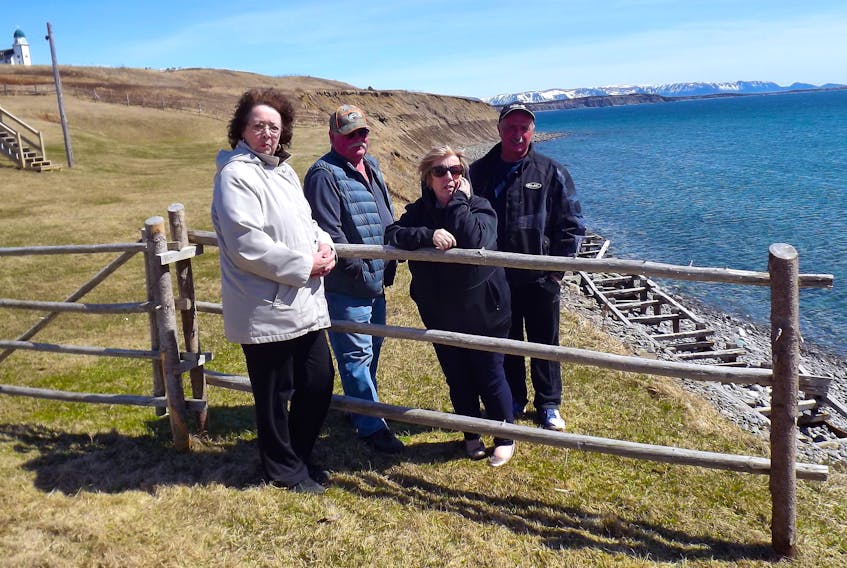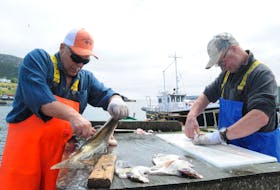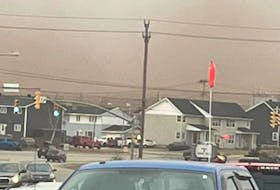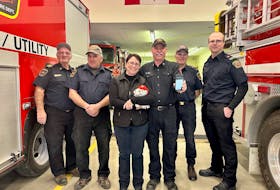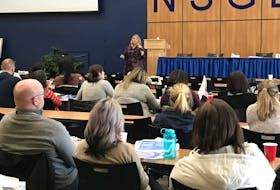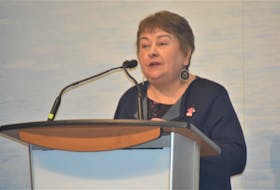CODROY, N.L. — Donald Gillis was still a boy when an old graveyard crumbled into the sea in Codroy. Fifty years later, now retired, he still remembers.
“No one would believe how much land has been gone, if I told you. There was houses out here,” says Gillis.
“There was bones,” offers neighbour Adeline Gale. “We came here in 1977, Gordon and I, and they were finding bones up there on the bank there then.”
Recovered remains were eventually reinterred back further from the water, closer to historic Holy Trinity Anglican Church, the church that’s lost the most land throughout the decades.
Warden Shirley Fountain says the current graveyard is more than 120 years old. The church’s green metal roof, topped by a unique cross, is visible from long distances and regularly draws a significant number of tourists who like to wander among the headstones.
“It’s a nightmare to think that might wash away, and it’s getting so close,” says Fountain. “It would be sad to see it gone.”
Fountain says to inter someone, the church must drill through about 10 feet of rock. Below that, it’s nothing but sand which will eventually give way.
Washed away
Gillis owns the home immediately across a narrow road from Jim Moore. Moore’s house is perched on the sandy cliffside just above a rotting, creosote wooden breakwater. Without any real buffer between the cliff and the sea, his property, and that of his neighbours’, are getting washed away.
Bordering Moore’s lawn, a wooden fence runs mere inches from the cliffside, and there’s also a growing sinkhole only a few feet away. Outside the fence is a fresh cavernous maw, a result of this past winter’s storm damage.
“It’s just a matter of time,” says Craig Collier.
A fisher who volunteers for maintenance work on the church, Collier also owns a home nearby. In fact, Collier owned Moore’s house 27 years ago, and says since then, close to 100 feet of land has eroded.
“There was a gate there. The gate is gone now,” he says, pointing to the end of a wooden fence line on the church land. “There was 75 feet of land on the outside of the gate.”
All four residents agree the land is eroding faster each year as the wind and the waves grow stronger. The water that once crashed against the breakwater, now hits the windows of their homes and batters their siding.
Residents believe there’s an easy fix: line the sandy cliff with armour stone.
“It’s not an expensive fix. It’s not going to cost millions of dollars,” says Collier.
The four maintain the community’s efforts to get the provincial government to deal with the growing threat to their homes and properties hasn’t met with much success.
“It would be simple, I think,” says Fountain. “It’s just to get (government) to be serious and do it.”
Government inaction
Part of the problem is that abutting sections of land are overseen by two different levels of government.
The federal government leases and maintains land for its small-craft harbours program. A fish plant employing about 100 people is located on that property. The federal roadway and breakwater leading to the plant has been reinforced with heavy armour stone.
Immediately adjacent is the rest of the town, including the sandy cliffside dotted with homes, which is under provincial oversight.
“When they’d done this rock here, the federal (government) done it. That’s as far as they were allowed to come,” recalls Gillis. “From the PCs to the Liberals, to the Liberals to the PCs, it doesn’t seem like anything’s been done.”
In fact, the federal government had laid the armour stone beyond its own leasehold and actually reinforced some of the provincial land before removing it again.
No matter who forms the next government in this week’s provincial election, it’s clear the Codroy residents no longer have any time for another round of what they feel are empty promises.
“It’s a campaign year,” shrugs Fountain.
“They’ll promise you anything, though, in an election,” agrees Collier. “It’s been over 30 years they’ve been trying to get this fixed.”
Political perspectives
The Gulf News spoke to candidates running in the provincial election about erosion concerns in Codroy.
Scott Reid, Liberal incumbent for the riding of St. George’s-Humber, which includes Codroy, says he had family members in the original gravesite that was lost decades ago, and has been trying for a long time to secure funding to halt the erosion. But he acknowledges, it’s a costly fix.
He’s spoken to engineers at the provincial Department of Transportation and Works and Department of Municipal Affairs and Environment, but as the road itself is not endangered, there’s no funding available.
After speaking with residents, he agrees it’s a serious problem that’s been getting progressively worse.
“It’s not a clear-cut thing. It’s not something that there’s a program for, coastal erosion. It’s becoming more of a problem though, and I’ve been trying to get some funds,” said Reid. “The program that I’ve been looking for the money from is a federal-provincial program related to coastal erosion, so there is some possibility there.”
Reid notes P.E.I. and other provinces are facing similar problems, and other areas are dealing with significant road damage because of erosion.
“There’s so many priorities in terms of roads and things like that in the Codroy Valley area, but it is a priority for that area and something I want to see addressed,” says Reid.
PC candidate Tom O’Brien says the armour stone placed by the federal government is a prime example of existing government inefficiency.
“That’s where people need to use more initiative to get stuff done,” says O’Brien. “That would have been an excellent opportunity for the province to partner with the federal government and have the work that needed to be done to secure that bank combined with the contract that the federal government was doing. It would have been more cost effective.”
He believes greater preventive maintenance has become crucial.
“We all do preventive maintenance on our vehicles so it doesn’t cost us big time down the road and there’s no difference in this,” says O’Brien. “It’s going to cost some money to fix it. There’s no doubt about that, but if it’s not fixed, down the road – it could very well be the next storm we get – it becomes a much larger problem that will cost a whole lot more.”
O’Brien says Codroy is not alone when it comes to battling climate change and he maintains it must become a priority for government.
“Severe weather patterns are increasing,” notes O’Brien. “There’s multiple areas across the province that if steps aren’t taken it’s going to be a very costly issue to deal with.”
O’Brien speaks from experience.
In 2005, he was elected as mayor of Stephenville on the same day a flood washed through the centre of town. He says 103 structures never went back into the flood area, and over 300 people were displaced. Since then the town has spent money to shore up the river banks and other infrastructure to prevent a recurrence.
“It has to be a priority. It’s an issue and it’s an issue that needs to be solved,” says O’Brien.
Like his opponents, NL Alliance candidate Shane Snook agrees erosion is a growing provincial problem.
“I live in Flat Bay and there’s a section of the road going through the community right alongside of the water and the erosion is making it get closer and closer, and there’s a school bus that goes over that road. You can’t get a more precious cargo,” he says.
Snook says he’s happy to sit down with committees and residents to discuss ideas.
Trying his best to find a truly workable solution is the most he will promise, however.
“It’s frustrating because, you know, making promises is how people get elected and people come to expect those kinds of promises, and by the same token, they’ve come to expect those promises to be broken. It’s a really dysfunctional system.”
RELATED
SaltWire Deep Dive: The economic impact of climate change

